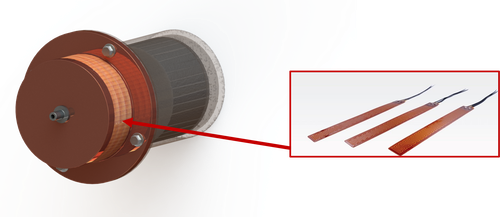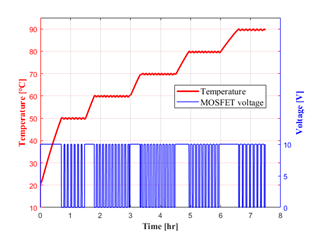
The first prototype of a rechargeable iodine tank for electric propulsion has been developed to fit within the envelope of a 0.5–1U CubeSat. The system includes an externally heated sublimator case to produce iodine vapors, driven by a spring-slider mechanism that pushes the propellant, while O-ring seals ensure leak-tightness. A custom fitting has been designed to integrate the tank with the fluidic interface developed by T4i and the University of Bologna.
The final prototype will use high-performance materials such as Inconel X750 for mechanical strength and corrosion resistance, and copper for its excellent thermal conductivity. While these heavier materials may offset some of the mass advantages of iodine’s high storage density, the overall benefits—both in terms of volume efficiency and cost—are expected to remain significant. In the current prototype, more conventional materials are used: stainless steel in areas contacting iodine, and aluminum elsewhere.
This initial prototype is not yet focused on on-orbit rechargeability. Instead, its main purpose is to investigate iodine sublimation behavior and how to control it. Heater mats are installed on the cylindrical surface of the copper lid, and type J and type N thermocouples are positioned using threaded holes in the flat surface. The heaters and sensors are connected in a feedback loop to ensure precise temperature control inside the sublimator, with the goal of deriving a relationship between heating power and iodine mass flow rate.

Testing has been conducted in a vacuum oven connected to a turbo pump, protected from iodine vapors by an activated charcoal filter. The mass flow rate was estimated by measuring the tank and filter masses before and after each test. Thermal control is implemented using a cRIO 9022 controller that reads temperature data and regulates the heater circuit via a MOSFET switch. The system compensates for both the energy needed to vaporize iodine and the thermal losses due to radiation. Insulating the tank surface helps reduce heat losses and enables higher internal temperatures with the same input power.
Experimental runs have explored operating temperatures from 50 °C to 90 °C, with measurements of corresponding PWM duty cycles and MOSFET output voltages. As expected, higher temperatures require increased power, reflected in higher duty cycles.
To complement experimental work, a thermal model has been developed to estimate power requirements in a space environment. The model treats the total heating power as the sum of the iodine vaporization energy and the heat lost via radiation through the insulation. By identifying heat exchange coefficients from lab data, the model can be used to predict system behavior in orbit, accounting for varying external temperatures and operating conditions.